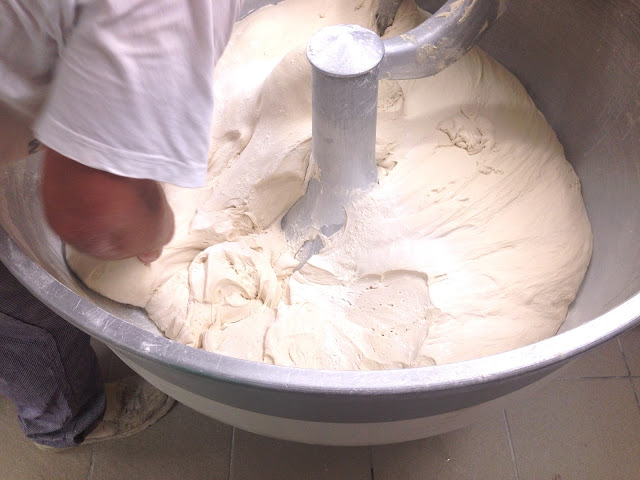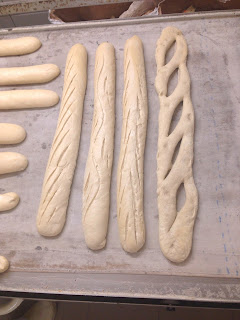 |
| Fancy breads he made just to show us the possibilities...whoa. |
The hot baguettes, still crackling, are taken next door to the store to be sold or put on a truck to sell in other villages. Stéphane's wife runs the store, and he has one other guy helping out in the bakery. The bread is some of the best I tasted all summer.
Then, he takes us through the process of making the dough. There are two kinds: one more rustic and the other a softer, more common flour used for basic baguettes. They produce different types of bread, too: the rustic one has bigger holes (the better to slather with butter!).
 |
| Basic baguette on the right, traditional dough on the left. |
 |
| I want to curl up and sleep in this cloud |
The dough is then measured by weight into the proper quantity, put in a machine to cut it into 36 exactly equal pieces, roughly shaped and sent to hang out for a while.
Stéphane then takes the little dough babies and rolls them into adult size baguettes, leaving them to rest seam side down on huge trays separated by the folds in big sheets of canvas. He showed us how to do it by hand, but usually a machine does it.
This dough rises overnight in a special fridge that gradually lowers the temperature to about 5 degrees C and then raises it to 6 or 7 degrees. It's super complex and fancy. Not a "try this at home!" kind of thing.
He makes some special loafs each day. These are batards with a nubbly surface!
 |
| My two up on top, and my friend's on bottom. Umm, one long cut? Yeah, I thought it was just practice. |
But he also showed us a pattern that is leaves, one that makes these bulbs, one with holes all down the line, one called a sausage (many shorter diagonal cuts close together), and one with a diamond pattern created by cutting two sets of diagonal lines. Some of these designs are traditional, others are his unique creations made for workshops and contests. They're beautiful.

It was such a cool morning. I loved seeing the craft and artistry that goes into bread-baking, but also the science and exactitude. I gotta get my hands on some yeast and get over that fear.
This video shows one of his original designs, a braid on top of a regular loaf. It's incredible to me how fast he makes it and how beautiful it turns out!
That's the final product. Whoa, right?
 |
| They look so cozy, just like the people who are going to enjoy the warm crackly bread in a little while. |





No comments:
Post a Comment